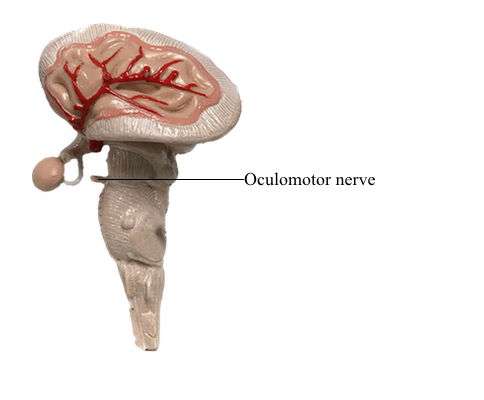Main Model

Cranial Nerves : III Oculomotor nerve

Oculomotor Nerve (CN III)
Functions: Somatic motor (general somatic efferent) and visceral motor (general visceral efferent - parasympathetic).
Nuclei: There are two oculomotor nuclei, each serving one of the functional components of the nerve. The somatic motor nucleus of the oculomotor nerve is in the midbrain. The visceral motor (parasympathetic) accessory (Edinger-Westphal) nucleus of the oculomotor nerve lies dorsal to the rostral two thirds of the somatic motor nucleus.
The oculomotor nerve (CN III) provides the following:
• Motor to the striated muscle of four of the six extra-ocular muscles (superior, medial, and inferior recti and inferior oblique) and superior eyelid (Latin levator palpebrae superioris); hence the nerve's name.
• Parasympathetic through the ciliary ganglion to the smooth muscle of the sphincter pupillae, which causes constriction of the pupil and ciliary muscle, which produces accommodation (allowing the lens to become more rounded) for near vision.
CN III is the chief motor nerve to the ocular and extra-ocular muscles. It emerges from the midbrain, pierces the dura mater lateral to the sellar diaphragm roofing over the hypophysis, and then runs through the roof and lateral wall of the cavernous sinus. CN III leaves the cranial cavity and enters the orbit through the superior orbital fissure. Within this fissure, CN III divides into a superior division (which supplies the superior rectus and levator palpebrae superioris) and an inferior division (which supplies the inferior and medial rectus and inferior oblique). The inferior division also carries presynaptic parasympathetic (visceral efferent) fibers to the ciliary ganglion, where they synapse. Postsynaptic fibers from this ganglion pass to the eyeball in the short ciliary nerves to innervate the ciliary body and sphincter pupillae.